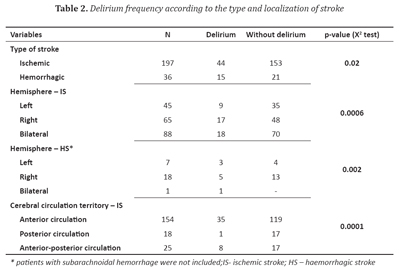
DELIRIUM AFTER STROKE
Abstract
Aim: To determine the frequency of delirium in patients with acute stroke.
Patients and methods: We assessed delirium prospectively in a sample of 233 consecutive patients with an acute (≤ 4 days) stroke using the Delirium Rating Scale R-98 and the Diagnostic and Statistical Manual of Mental Disorders - Fourth Edition criteria for delirium.
Results: Delirium was diagnosed in 59 (25.3%) patients. Patients with delirium were older comparing to those without delirium (70.0±11.3 vs. 64.7±10.4 years of age; p=0.001). Delirium was significantly more frequent in hemorrhagic comparing to the ischemic type of stroke (41.6% vs. 22.3%, p=0.02). In patients with the ischemic stroke, the delirium was more frequent among those with right hemispheric lesion (26.2% vs. 20.5%, p=0.0006); however, in hemorrhagic stroke delirium was more frequent in patients with left hemispheric lesion (42.9% vs. 27.8%, p=0.002). Delirium was also more frequent in patients with ischemic stroke in the anterior than posterior cerebral circulation territory (22.7% vs. 5.6%, p=0.0001).
Conclusion: Delirium develops in approximately one quarter of patients in the acute phase of stroke. Possible factors which predispose the occurrence of delirium are ages over 65 years, hemorrhagic stroke, ischemic stroke in anterior cerebral circulation, lesion of right hemisphere in ischemic stroke and left hemisphere in hemorrhagic stroke.
Keywords
DOI: 10.5457/ams.v38i1.51
